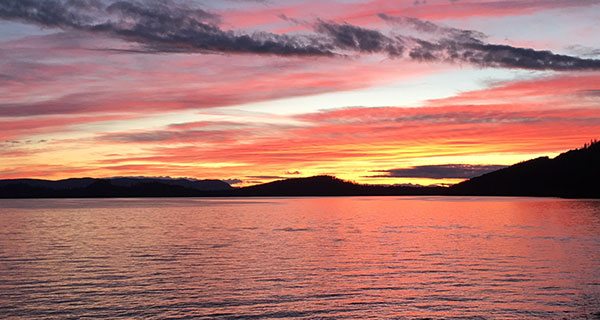 It was a long February. As my neighbour, a veteran of several more Skelhp winters than I, likes to say: “Cold, dark and wet.” Exactly.
It was a long February. As my neighbour, a veteran of several more Skelhp winters than I, likes to say: “Cold, dark and wet.” Exactly.
And then a day like March 3 happens. It dawned lighter. That’s normal up here this time of year. More light starts creeping in around 7 a.m. each morning. It’s an almost-spring novelty to not have to awaken to a pitch-dark house. I know spring officially arrives on March 20 but in our part of the world, we begin the rites of acknowledgement early.
March 3 was special for many reasons.
First, we saw magnificent spouts and splashes off Ball Point just after breakfast. We quickly trained the spotting scope on the northwest flank of Hardy Island and immediately saw three orcas. I still think of them as killer whales, the term all the coast used in my youth.
The big dad of the small family pod had a massive dorsal fin. From our side of the bay, it looked 1.5 metres tall at least, maybe two metres. What we assumed was the big mom was almost as long in body as the male. A small calf swam between them. As we watched, they began to patrol slowly east along Hardy’s granite coast. We’ve seen this behaviour before – they’re hunting for hauled-out seals and sea lions by stealthily sneaking along the water’s edge.
While the orcas were seeking their breakfast, we were visited by a new species of airborne megafauna. A massive American golden eagle circled in front of the house and chose a strong fir bough to settle on, right in front of and just slightly above our deck.
What a bird. Its wingspan was at least two metres, and the head and curved beak were authoritative to say the least.
Then I realized that I had moved our extremely lifelike chainsaw bald eagle onto the granite ledge beneath the deck. We immediately noticed how the real eagle was carefully casing the phoney. Our house decoy had worked its magic. The American stayed to size up the competition for more than 10 minutes before it muscularly flapped skyward and curved away over the bay.
Next our gaze fell to the water surface just in front of the beach. A raft of seven land otters were busily crossing our bay, each leaving a trailing (tailing?) wake. We wondered if these were an extended family or a phalanx of pals? Who knows, but they were purposeful and poised at the same time. Their water-borne movements were wriggly, but nowhere as snaky and slithery as their land-borne travel. Their Haida name, sluuguus (thank you, Kwiaahwah Jones), is a much truer descriptor.
After breakfast, I walked to the mailbox. I noticed fresh animal tracks on the melting ice on the koi pond. A closer inspection revealed that a large raccoon had passed over the surface during the night. Under the ice, the nine koi huddled beneath the granite rock shelter I built for them. For a decade, their underwater world has remained undisturbed.
Walking up the gravel road, I spied some jumpy tracks heading for the water. They weren’t deer and yet were big enough to suggest purposeful travel to the ocean’s edge, 50 metres away. Squirrel? Mink? Maybe even a sluuguu heading out to fish?
I’m still not sure. I followed them down the trail and took a picture of their focused exit.
Farther up the road, I spied a black-tailed doe and one fawn carefully watching my progress. Suddenly I realized that two of her last year’s triplets were missing. Then I remembered that a few weeks ago we had sadly spied one of them dead in the ditch beside the highway. Now yet another was missing. I wondered if the resident Skehlp cougar was the reason?
High above, a blue sky beckoned as the first rays of sunlight shone down upon the forested world. It was almost warm enough to take off my jacket, perhaps 4C or 5C.
March 3, 2018, was the first harbinger of the Skehlp spring. Undoubtably there will be a few more rainy days this month but change is present.
Troy Media columnist Mike Robinson has been CEO of three Canadian NGOs: the Arctic Institute of North America, the Glenbow Museum and the Bill Reid Gallery.
The views, opinions and positions expressed by columnists and contributors are the author’s alone. They do not inherently or expressly reflect the views, opinions and/or positions of our publication.







